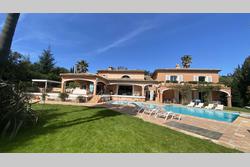Grimaud
Visit Grimaud: A Medieval Village at the Heart of Provence
Grimaud, with its medieval and Provençal village, boasts a history that dates back to Roman times. Once the largest settlement in the area with 1,000 villagers, Grimaud gave its name to the region, which was known as "the Gulf of Grimaud" until the late 19th century, when it became the more famous "Gulf of Saint-Tropez."
Explore Grimaud's Historical Heritage
Grimaud, a strategic point in the region, commanded the Gulf until the 17th century. It was a key control point from the north and the Massif des Maures. The village’s inhabitants initially lived within the walls of the Château, and gradually, the village expanded. Evidence of this growth remains in landmarks such as the Church of St. Michael, the Chapel of the Penitents, the Chapel of St. Roch, the St. Roch Mill, and lower down, the Chapel of Notre-Dame de la Queste.
Other notable historical sites include the Pont des Fées, part of an ingenious water supply system for the village. Villagers would gather water from the fountain at the current Place Neuve.
Grimaud is also home to remarkable architectural heritage. Strolling through the narrow streets, admiring the period houses with flowers adorning the exterior, is a true delight. And, of course, don’t miss the "recent" heritage of Port Grimaud!
The commune of Grimaud, nestled between land and sea, offers a variety of experiences for its visitors and is classified among the "most beautiful detours of France."
Port Grimaud: A Modern Masterpiece
Before 1966, the bottom of the Gulf was marshland. In that year, architect François Spoerry (who passed away in 1999 and was also the designer of the European Tower in Mulhouse) embarked on the creation of what would become Port Grimaud.
Today, Port Grimaud includes:
Over 2,400 homes (including 1,100 individual houses)
More than 2,000 boat spaces
7 km of canals
12 km of quays
Covering 90 hectares, Port Grimaud attracts approximately 500,000 visitors annually and ranks as one of the most visited tourist sites in France. The area, once a place for agricultural activities or hunting, has transformed into a vibrant coastal destination, especially after the 1960s when tourism began to take off.
François Spoerry purchased land in 1964 with the idea of creating a dream village where land and sea would intertwine. His vision included homes in the Provençal and Mediterranean styles, offering boat owners the unique opportunity to have their boats docked at the end of their gardens.
Must-See Highlights in Port Grimaud
The Picturesque Decorations: Many façades feature trompe-l'œil paintings, such as simple architectural motifs, statues, or characters like the Provençal woman leaning from her balcony in Place du Marché.
Place du 14 Juin: Named after the date the construction permit for the village was obtained, after much opposition.
Place François Spoerry & The Magistral Fountain (Port Grimaud 2): This square features beautiful blue and white ceramic decorations. The monumental fountain, decorated with Azulejos, features a portrait of Port Grimaud’s founder.
In 2002, this remarkable lakeside city was awarded the "20th Century Heritage" label by the Ministry of Culture, highlighting its architectural success.
For more details, visit the official website: Mairie de Grimaud





























Share this page